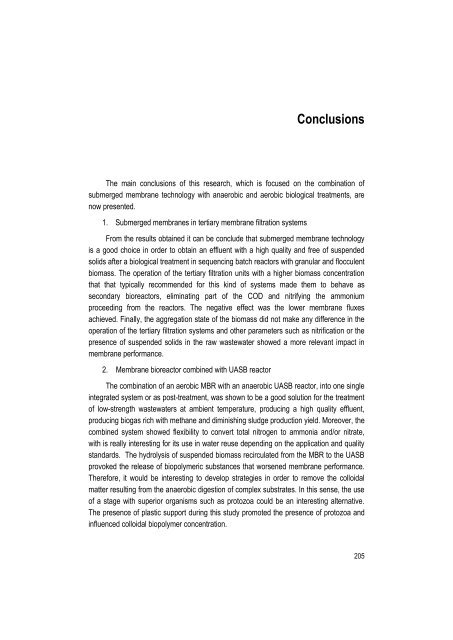Combining submerged membrane technology with anaerobic and ...
Combining submerged membrane technology with anaerobic and ...
Combining submerged membrane technology with anaerobic and ...
Create successful ePaper yourself
Turn your PDF publications into a flip-book with our unique Google optimized e-Paper software.
ConclusionsThe main conclusions of this research, which is focused on the combination of<strong>submerged</strong> <strong>membrane</strong> <strong>technology</strong> <strong>with</strong> <strong>anaerobic</strong> <strong>and</strong> aerobic biological treatments, arenow presented.1. Submerged <strong>membrane</strong>s in tertiary <strong>membrane</strong> filtration systemsFrom the results obtained it can be conclude that <strong>submerged</strong> <strong>membrane</strong> <strong>technology</strong>is a good choice in order to obtain an effluent <strong>with</strong> a high quality <strong>and</strong> free of suspendedsolids after a biological treatment in sequencing batch reactors <strong>with</strong> granular <strong>and</strong> flocculentbiomass. The operation of the tertiary filtration units <strong>with</strong> a higher biomass concentrationthat that typically recommended for this kind of systems made them to behave assecondary bioreactors, eliminating part of the COD <strong>and</strong> nitrifying the ammoniumproceeding from the reactors. The negative effect was the lower <strong>membrane</strong> fluxesachieved. Finally, the aggregation state of the biomass did not make any difference in theoperation of the tertiary filtration systems <strong>and</strong> other parameters such as nitrification or thepresence of suspended solids in the raw wastewater showed a more relevant impact in<strong>membrane</strong> performance.2. Membrane bioreactor combined <strong>with</strong> UASB reactorThe combination of an aerobic MBR <strong>with</strong> an <strong>anaerobic</strong> UASB reactor, into one singleintegrated system or as post-treatment, was shown to be a good solution for the treatmentof low-strength wastewaters at ambient temperature, producing a high quality effluent,producing biogas rich <strong>with</strong> methane <strong>and</strong> diminishing sludge production yield. Moreover, thecombined system showed flexibility to convert total nitrogen to ammonia <strong>and</strong>/or nitrate,<strong>with</strong> is really interesting for its use in water reuse depending on the application <strong>and</strong> qualityst<strong>and</strong>ards. The hydrolysis of suspended biomass recirculated from the MBR to the UASBprovoked the release of biopolymeric substances that worsened <strong>membrane</strong> performance.Therefore, it would be interesting to develop strategies in order to remove the colloidalmatter resulting from the <strong>anaerobic</strong> digestion of complex substrates. In this sense, the useof a stage <strong>with</strong> superior organisms such as protozoa could be an interesting alternative.The presence of plastic support during this study promoted the presence of protozoa <strong>and</strong>influenced colloidal biopolymer concentration.205
















